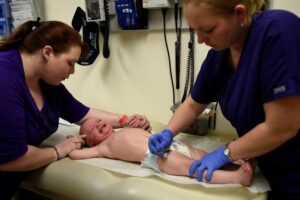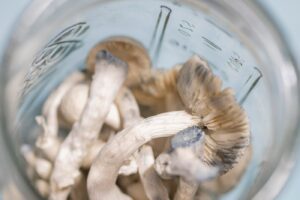Individuals with autism spectrum disorder (ASD) often experience disordered sleep — in fact, studies show that between 50% and 83% of individuals with ASD experience insomnia (difficulties falling and/or staying asleep) and/or day-time sleepiness with nighttime wakefulness, causing disruption of their circadian rhythms.1
People with ASD take about 11 minutes longer to fall asleep than neuro-typical individuals. Many wake up several times each night. And the sleep they do get is less restorative; individuals with ASD spend just 15% of their sleeping hours in the rapid eye movement (REM) sleep stage compared with neuro-typical individuals, who spend 23% of each night’s sleep in REM. Reductions in REM might further heighten the already present learning challenges for individuals with ASD.2
Without understanding their specific etiology, sleep disorders are often difficult to treat. Increased knowledge regarding the disordered sleep associated with ASD could therefore lead to treatment improvements for these patients.
Potential Causes of Disordered Sleep With ASD
Within the varied ASD population it is difficult to pinpoint one direct cause of sleep disruptions. There are, however, several neurologic factors that appear to contribute.
Sleep-Wake Cycle
As mentioned earlier, individuals with ASD often awaken during the night, or experience sleepiness or wakefulness at inappropriate times. Now, researchers believe this may be due to disruptions to their sleep-wake cycle.
This cycle encompasses the natural shifts one’s body should experience in a 24-hour period: wakefulness, deep sleep and REM sleep. Typically, the body shifts between deep and REM sleep every 90 to 120 minutes. Contrastingly, individuals with ASD spend less time in REM.
One theory as to why this happens revolves around the two processes that determine wakeful or sleepy behavior: a homeostatic process that slowly builds-up sleepiness throughout the day, and a circadian rhythm that determines wakeful hours.
The homeostatic process to promote sleepiness should increase while one is awake, producing sleep inducing substances; the circadian process should keep him or her awake during appropriate hours, but it is easily influenced by light, hormones, body temperature, genetics and behaviors.
Given the measured reductions of REM sleep in individuals with ASD, along with evidence that individuals with ASD take longer to fall asleep, researchers suggest that spectrum disorders may interfere with the synergy of homeostasis and the circadian process.1
GABA, Melatonin, and Serotonin
Delving deeper into the world of hormones and neurotransmitters, research suggests that GABA and melatonin may contribute to disordered sleep with ASD. The neurotransmitter GABA activates the GABA-A receptor, regulating the deep-sleep-REM cycle. But individuals with ASD have fewer GABA-A receptors, making it more difficult to regulate sleep.
This could also explain why some individuals with ASD display decreased nighttime melatonin levels that coincide with increased serotonin levels: GABA signals impact the final steps of melatonin synthesis. Thus, reduced GABA-A receptors could trigger melatonin deficiencies, increased serotonin levels, and difficulties in falling or staying asleep.1
Contributing Comorbidities
While these neurologic triggers could hamper sleep, it is important to identify and address ASD comorbidities that may contribute to disruptions. Many people with ASD also experience gastrointestinal disorders and sensory disorders, both of which could make sleeping more difficult. Additionally, ADHD and anxiety disorders are common with ASD, heightening sleep challenges, especially when stimulating medications are prescribed to treat ADHD.2
Determining Cause to Target Treatments
With so many factors contributing to sleep disorders, careful monitoring may be key to determining individual triggers. One effective method may be polysomnography. This sleep test, conducted in a lab, tracks brain waves, eye and limb movement, and breathing patterns during sleep. It can help identify specific patterns and disruptions in deep and REM sleep that may point to sleep-wake cycle or neurotransmitter-related obstacles.
Unfortunately, many individuals with ASD could be thrown off by the anxiety of a new environment. As such, some clinicians offer at-home polysomnography, albeit with less accurate results. Others recommend actigraphy, where the individual puts on a wristwatch-like device that records his or her movements throughout the night. While less illuminating, this form of monitoring can identify certain patterns of sleep and wakefulness. Finally, asking for family observations and help in maintaining a sleep diary could further identify specific moments of disruption.3
With a better understanding of the causes of disruptions, it becomes easier to prescribe medications to improve sleep. The following are suggested treatment options that have demonstrated promise targeting specific causes of disrupted sleep.
1. Melatonin: When decreased melatonin levels impact sleep for individuals with ASD, melatonin supplements may help counter sleep disruptions related to hyperarousal. More research is needed to determine whether melatonin can address anxiety-related sleep disorders.
2. Antipsychotics: With two studies, one involving risperidone and one involving quetiapine treatment, participants with ASD displayed marked sleep improvements after 6 months and 8 weeks, respectively. Additionally, day time behaviors improved with better sleep, but these medications do have the potential for adverse side effects.1
3. Benzodiazepines and hypnotics: To address issues related to reduced GABA receptors, benzodiazepines (BZDs) can act on GABA-A and G receptors to reduce interferences with melatonin production.4
4. Alpha-2-adrenergic agonists: When an ADHD comorbidity appears to trigger disordered sleep, off-label alpha agonist prescriptions may help. Two open-label studies examined the use of clonidine for disordered sleep in children without ASD, finding the prescription made it easier for participants to fall and stay asleep, with few adverse effects. More recently, researchers conducted a guanfacine trial in children with ASD. Results showed that 45% of participants had at least a 50% hyperactivity reduction, which could improve sleep. But, with this trial, participants experienced adverse effects including drowsiness and irritability.1
Conclusions
Several interventions could improve sleep quality for children and adults with ASD, and identifying the specific origin of disordered sleep will help make them more successful. Finally, considering comorbidities and other medications — with a specific eye to drug-drug interactions — will help reduce sleep disruptions, while mitigating unwanted treatment outcomes.
References
1. Ballester P, Richdale AL, Baker EK, Peiro AM. Sleep in autism: a biomolecular approach to aetiology and treatment. Sleep Medicine Reviews. 2020;54:101357. doi:10.1016/j.smrv.2020.101357
2. Neumeyer AM, Anixt J, Chan J. et al. Identifying associations among co-occurring medical conditions in children with autism spectrum disorders. Acad Pediatri. 2019;19(3):300-306. doi:10.1016/j.acap.2018.06.014
3. Furfaro H. Sleep problems in autism, explained. Spectrumnews. Published online February 6, 2020.
4. Griffin III CE, Kaye AM, Bueno FR, Kaye AD. Benzodiazepine pharmacology and central nervous system- mediated effects. Ochsner J. 2013;13(2): 214-223
This article originally appeared on Neurology Advisor





